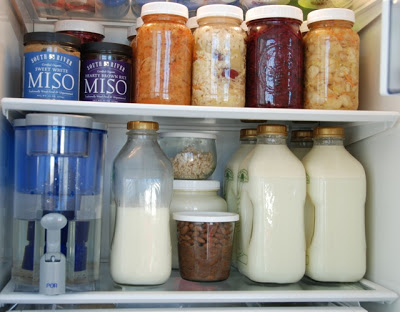Originating in the 18th century, the term chatelaine meant a chain or clasp which held useful objects, most importantly the keys to the castle. Chatelaines were worn most often by the mistress, but sometimes by the master of the house, and the term itself later came to mean simply, the keeper of the castle.
In Sharon Astyk’s book Independence Days, she reintroduces the word and newly defines it as: the person whose job it is to make sure the food storage is organized and taken care of. In my castle that would be me.
 (Yes, I told you I had obsessive tendencies, but that’s besides the point)
(Yes, I told you I had obsessive tendencies, but that’s besides the point)
 This is what’s in my larder and fridge/freezer now in LIC. The bulk of the season’s bounty is still in the Berkshires. Part of this chatelaine’s work is to haul back to a New York City apartment a new supply of preserved food and raw milk every 6 or so weeks throughout the winter months.
This is what’s in my larder and fridge/freezer now in LIC. The bulk of the season’s bounty is still in the Berkshires. Part of this chatelaine’s work is to haul back to a New York City apartment a new supply of preserved food and raw milk every 6 or so weeks throughout the winter months.
It’s no surprise that the term chatelaine lost its punch when most of us were stopping by the grocery store every few days to buy whatever we needed. But now that many of us are making an effort to eat seasonally & locally and learning to grow and preserve our own food, the task of the chatelaine is once again at the fore.
Having been growing and preserving my own food for the last 6 years, I know that managing the food storage throughout the year is a big part of it all. And that it’s a constantly evolving process.
Fine-tuning Around Here Includes:
- Using up the canned, frozen and fridged preserved goods. Learning what we like to eat, how much of each item throughout the year, and finding new ways to use preserved food in cooking. The challenge for me has been keeping us in straight-up veggies throughout the winter so that we can eat what we grow all year. I know it involves the freezer but I’m still working on what freezes best and what suits our tastes.
- Keeping the dry larder stocked, organized and efficient. This includes the grains, beans, spices, herbs and other dried goods. Finding a balance between storing enough, and using them when they are at their most fresh is important. Sussing out local sources for goods in this category is an on-going challenge. And drying and dehydrating are preserving methods that I need to explore more.
- Storing and using up ‘cellared’ vegetables. Like many of us today, I don’t have a root cellar. But there are things that I grow that can be stored without too much effort. Garlic, onions and winter squash are the easiest for me. Using these up before I get soft spots on my pumpkins or a waft of bad onion hitting me in the face is a priority.
- Generally stretching the season’s bounty. For me it’s a circle. What I learn with each passing year tells me what I need to grow, and allows me to eat as close to the source as possible. First from my land, second from my neighboring farmers’ land and on out from there.
gap
Here’s the thing: you don’t have to have a garden bigger than your house, or even grow your own food. You don’t have to can 500 jars of tomatoes in the sweltering heat of august. You don’t have to eat only things that grow within 100 miles from your home to do the chatelaine’s work. It’s about taking stock, organizing and using up what you have, knowing what you like and need so that you can make better choices for you and your family, the people and animals that provide what you eat, and the planet on which we all live.
It’s not all or nothin’ peeps, it’s a mind-set and some action. The amount is up to you and I assure you it will vary over time.